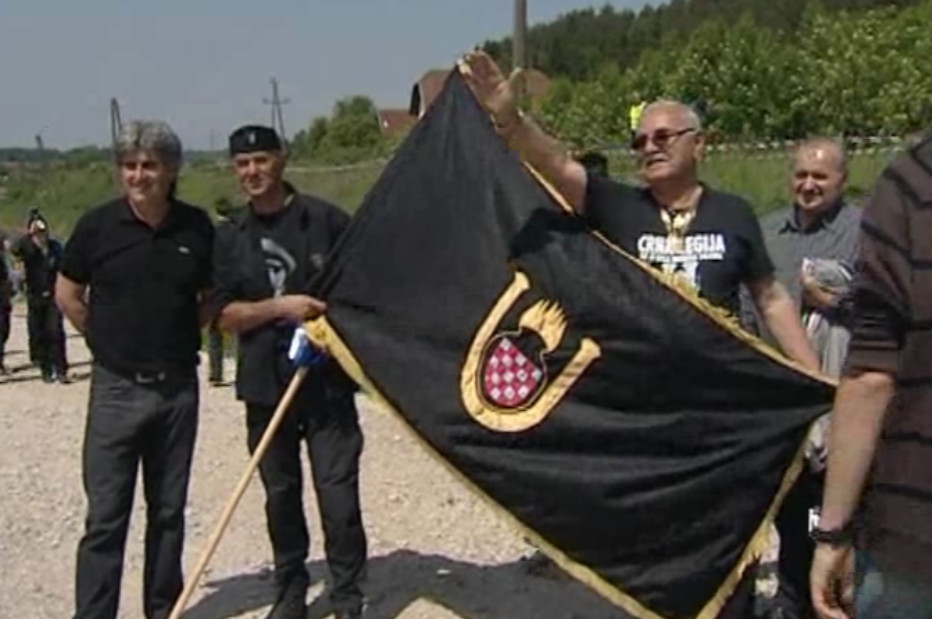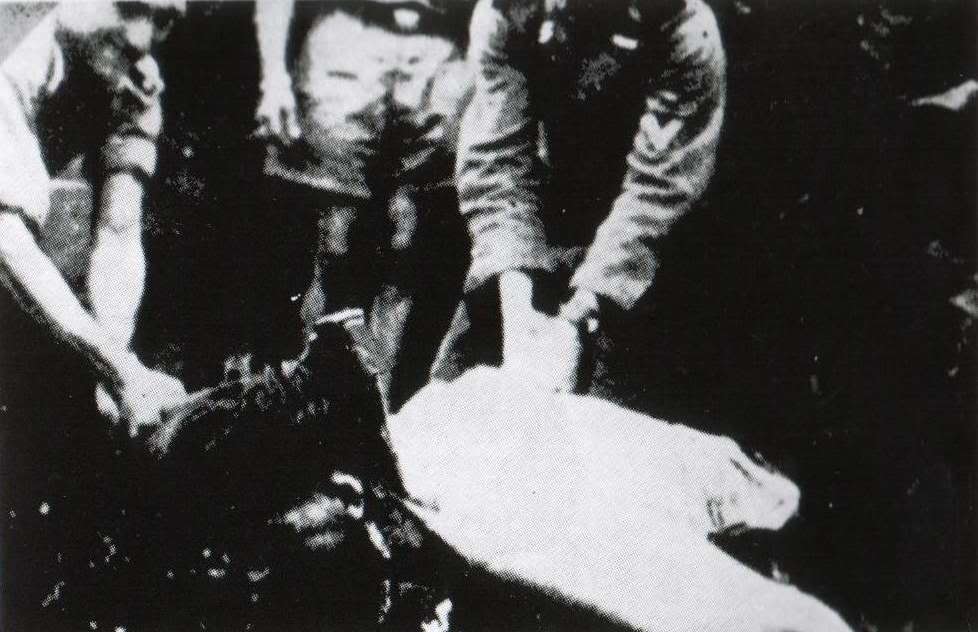
Views: 3314
 Croatia’s President Kolinda Grabar-Kitarovic with Croatian diaspora in Canada holding the flag of WWII Nazi-Ustashi Independent State of Croatia
Croatia’s President Kolinda Grabar-Kitarovic with Croatian diaspora in Canada holding the flag of WWII Nazi-Ustashi Independent State of Croatia
Croatia’s president, the former deputy NATO secretary general for public diplomacy Kolinda Grabar-Kitarovic, decided to pay homage to Nazis of the Ustasha Nazi puppet regime of Croatia shot by Yugoslav partisans at the end of World War II. Grabar-Kitarovic’s tone deafness in choosing Victory in Europe week to honor dead Nazis shocked the Balkans and the rest of Europe.
The Ustasha, along with their Slovenian and Serb loyalists to the Nazi puppet regime, were killed by the partisans under the command of anti-fascist guerrilla leader Josip Broz Tito. Most of the Ustasha were killed in the Au strian town of Bleiburg, as well as in the Slovenian towns of Macelj and Tezno. The Ustasha were attempting to flee among hordes of other refugees from Tito’s forces who were mopping up the last remaining pockets of Nazi resistance in Yugoslavia. The Ustasha actually sought the protection of British forces that were advancing from Austria toward the Yugoslav border. It was known to the Ustasha that the Serbian Chetnik guerrilla leader, the non-Communist, Draza Mihailovic, who had battled the Ustasha had maintained a special relationship with the British Special Operations Executive (SOE) intelligence and military officials while also cooperating with the Axis powers of Germany and Italy. However, the British had struck a deal with Tito’s partisans at the expense of the Chetniks and although they did not directly aid the Ustasha, they had no problem letting the Office of Strategic Services (OSS) and the Vatican help spirit out of Yugoslavia some of the top Ustasha officials in the infamous «Rat Line» operation coordinated with Croatian Catholic war criminal Monsignor Krunoslav Draganovic.
strian town of Bleiburg, as well as in the Slovenian towns of Macelj and Tezno. The Ustasha were attempting to flee among hordes of other refugees from Tito’s forces who were mopping up the last remaining pockets of Nazi resistance in Yugoslavia. The Ustasha actually sought the protection of British forces that were advancing from Austria toward the Yugoslav border. It was known to the Ustasha that the Serbian Chetnik guerrilla leader, the non-Communist, Draza Mihailovic, who had battled the Ustasha had maintained a special relationship with the British Special Operations Executive (SOE) intelligence and military officials while also cooperating with the Axis powers of Germany and Italy. However, the British had struck a deal with Tito’s partisans at the expense of the Chetniks and although they did not directly aid the Ustasha, they had no problem letting the Office of Strategic Services (OSS) and the Vatican help spirit out of Yugoslavia some of the top Ustasha officials in the infamous «Rat Line» operation coordinated with Croatian Catholic war criminal Monsignor Krunoslav Draganovic.
British intelligence had, for some time, played an underhanded role in the Balkans. British intelligence had ties to the «Crna Ruka» (Black Hand) operation of which Gavrilo Princip, the assassin of Austrian Archduke Franz Ferdinand, was a member. Princip’s assassination of Ferdinand in 1914 helped trigger off World War I. At the same time, British intelligence was kick-starting another Black Hand group in Palestine, known as «al-Kaff al-Aswad» in Arabic, which began attacking Jewish settlers at the same time British Lord Balfour was promising Palestine to the Zionists as a future Jewish homeland. The British and their American allies, mostly through the auspices of NATO, continue to play dangerous intelligence games in the Balkans.
 A head of the WWII Independent State of Croatia – Ante Pavelić together with the Roman Catholic monks
A head of the WWII Independent State of Croatia – Ante Pavelić together with the Roman Catholic monks
Many of the Ustasha leadership, including the Nazi puppet dictator Ante Pavelic, managed to escape the firing squads planned by Tito’s partisans and they fled to Argentina, courtesy of hastily-prepared Vatican passports authorized by Pope Pius XII. During the Cold War, Draganovic, Pavelic, and other Croatians served as exiled members of the Central Intelligence Agency’s Operation Gladio. From 1959 to 1962, Draganovic helped the CIA run Ustasha clandestine agents in Yugoslavia who passed on intelligence about the Tito government to the West.
Grabar-Kitarovic laid wreaths at Ustasha memorials in the three towns where the Ustasha forces met their fates. The memorial in Bleiburg serves as a rallying point for neo-Nazis annually who come to pay tribute to the Nazi Ustasha killed by Tito’s forces. Grabar-Kitarovic was accompanied at the ceremonies by Croatian Prime Minster Zoran Milanović, a member of the Social Democratic Party and a former member of Croatia’s delegation to NATO in Brussels, and who, as is typical for a Soros loyalist, is a strong promoter of gender equality and human artificial insemination.
Grabar-Kitarovic represents a phalanx of Nazi sympathizers and aspirant nations who serve in senior government positions throughout NATO countries in Eastern Europe, including the three Baltic States, Albania, Hungary, Poland, and Ukraine. NATO headquarters has always been rife with pro-Nazi senior officers on its staff, particularly those from Denmark, the Baltic nations, and Belgium. Rasmussen was the prime minister of Denmark before becoming NATO Secretary-General.
Grabar-Kitarovic’s actions, during the period the world was commemorating the 70th anniversary of the defeat of the Nazis has led to condemnations from her own country, as well as others, including Russia and Serbia, that helped defeat Hitler and his allies. In April 2015, Grabar-Kitarovic failed to attend a commemoration at the Nazi concentration camp of Jasenovac where an estimated 83,000 people died at the hands of the Ustasha. The victims, although primarily Serbs, also included Roma (gypsies), Jews, and anti-Nazi Croatians in that order, mainly because the names of the many of the Roma killed were never registered.
The CIA’s interest in using Yugoslav minority groups led by Nazi and neo-Nazi elements is illustrated in a SECRET limited copy document, dated October 1985, titled «Yugoslavia: Internal Security Capabilities». The document points out that Yugoslavia’s decentralized internal security forces after Tito’s death in 1980 provided some unique opportunities to make common cause with those seeking to foment «ethnic or interregional conflict» in the country. The CIA took comfort in the fact that in 1985, Yugoslavia’s state security network was «an array of regional and provincial organizations only loosely controlled by the federal government». In other words, Yugoslavia was a sitting duck for penetration by CIA-supported Nazi emigré groups, particularly the Croatians and Albanians.
Ustasha leader Draganovic arranged for the Nazi «Butcher of Lyon,» Klaus Barbie, to escape to Argentina at the end of World War II. When Barbie asked Draganovic why he was helping him to escape, the Catholic prelate tipped his hand on future Western intelligence operations in the Balkans and Europe, replying, «We have to maintain a sort of moral reserve on which we can draw in the future».
That «moral reserve» would later be used by the CIA inside Yugoslavia to incite ethnic tensions to bring down the Communist-led government. In fact, the CIA report appears to relish in the fact that Albanians in Kosovo were the first to rebel against the federal government in 1981, the year after Tito’s death. The CIA document also states that for any significant regional discontent to materialize, the Yugoslav People’s Army (YPA), «the national institution least affected by regional divisions,» would have to be dealt with by the external forces hoping to capitalize on Yugoslavia’s ethnic divisions. The 1981 Kosovo riots by Albanian nationalists apparently had the tacit support of the regional Kosovo communist leader and his two top security officials. They were removed from office by the federal government. A redacted paragraph providing more information on the Kosovo officials may include details of previous contact with them or their associates by the CIA station in Belgrade. The CIA report does state that Yugoslav Interior Minister Dobroslav Culafic stated that in 1984 and 1985, «16 underground organizations and groups with 362 members had been uncovered» in Kosovo. The former Interior Minister, Stane Dolanc, is quoted in the CIA report as stating that the Kosovo Communist leadership failed to apprise Belgrade on the extent of the Albanian nationalist problems in Kosovo. The CIA report also describes nascent nationalist uprisings in Croatia, Vojvodina, and Bosnia-Herzegovina. The CIA report mentions the Croatian “rebellion” of 1971, which saw a number of Croatian nationalists propose rights for the Croatian language and the idea of incorporating Herzegovina into the Yugoslav republic of Croatia.
 A neo-Ustashi Croat family today
A neo-Ustashi Croat family today
The Croatian nationalist rebellion of 1971, now dubbed by the Sorosites and one of their their virtual house organs, Wikipedia, as the “Croatian Spring,” was put down by force and among those jailed was the future first president of independent Croatia, communist-turned-nationalist Franjo Tudjman. The current president, Grabar-Kitarovic, is a member of Tudjman’s party, the Croatian Democratic Union, seen by many as the successors to the Nazi Ustasha fascists. From Croatia to Ukraine and Romania to Latvia, there is a resurgence of Nazism in Europe, brought on by decades of machinations by the CIA, National Endowment for Democracy, U.S. Agency for International Development (USAID), and Soros’s Open Society Institute. This resurgence could be referred to as the «Fourth Reich Lite».
 Zagreb 1941 – a capital of the Nazi-Ustashi Independent State of Croatia
Zagreb 1941 – a capital of the Nazi-Ustashi Independent State of Croatia
Originally published on 2015-05-19
Author: Wayne Madsen
Source: Strategic Culture Foundation
Origins of images: Facebook, Twitter, Wikimedia, Wikipedia, Flickr, Google, Imageinjection, Public Domain & Pinterest.
Read our Disclaimer/Legal Statement!
Donate to Support Us
We would like to ask you to consider a small donation to help our team keep working. We accept no advertising and rely only on you, our readers, to keep us digging the truth on history, global politics and international relations.
[wpedon id=”4696″ align=”left”]
 Ustashi Croat soldiers are killing Serb prisoner in Jasenovac death camp during WWII
Ustashi Croat soldiers are killing Serb prisoner in Jasenovac death camp during WWII







